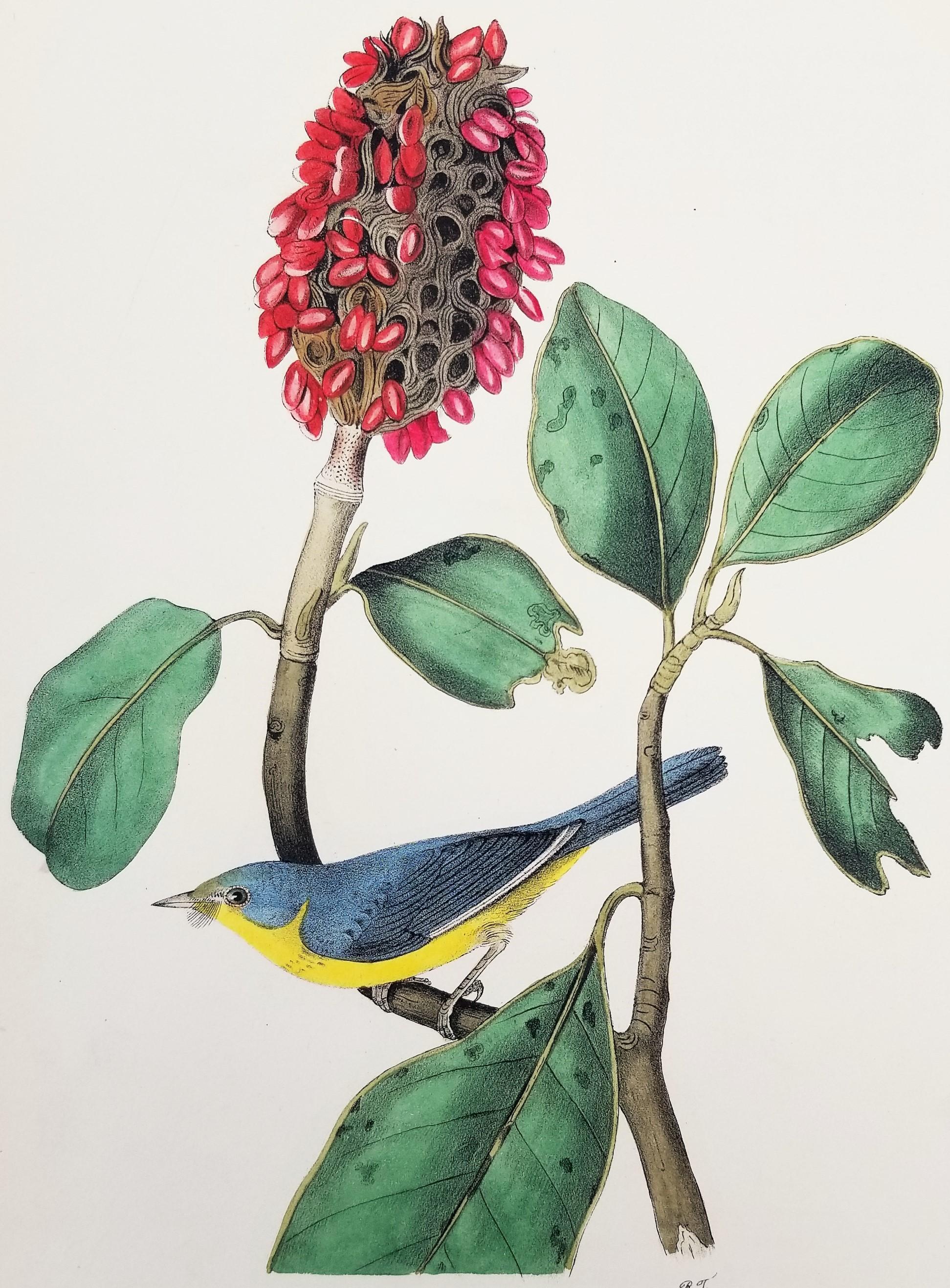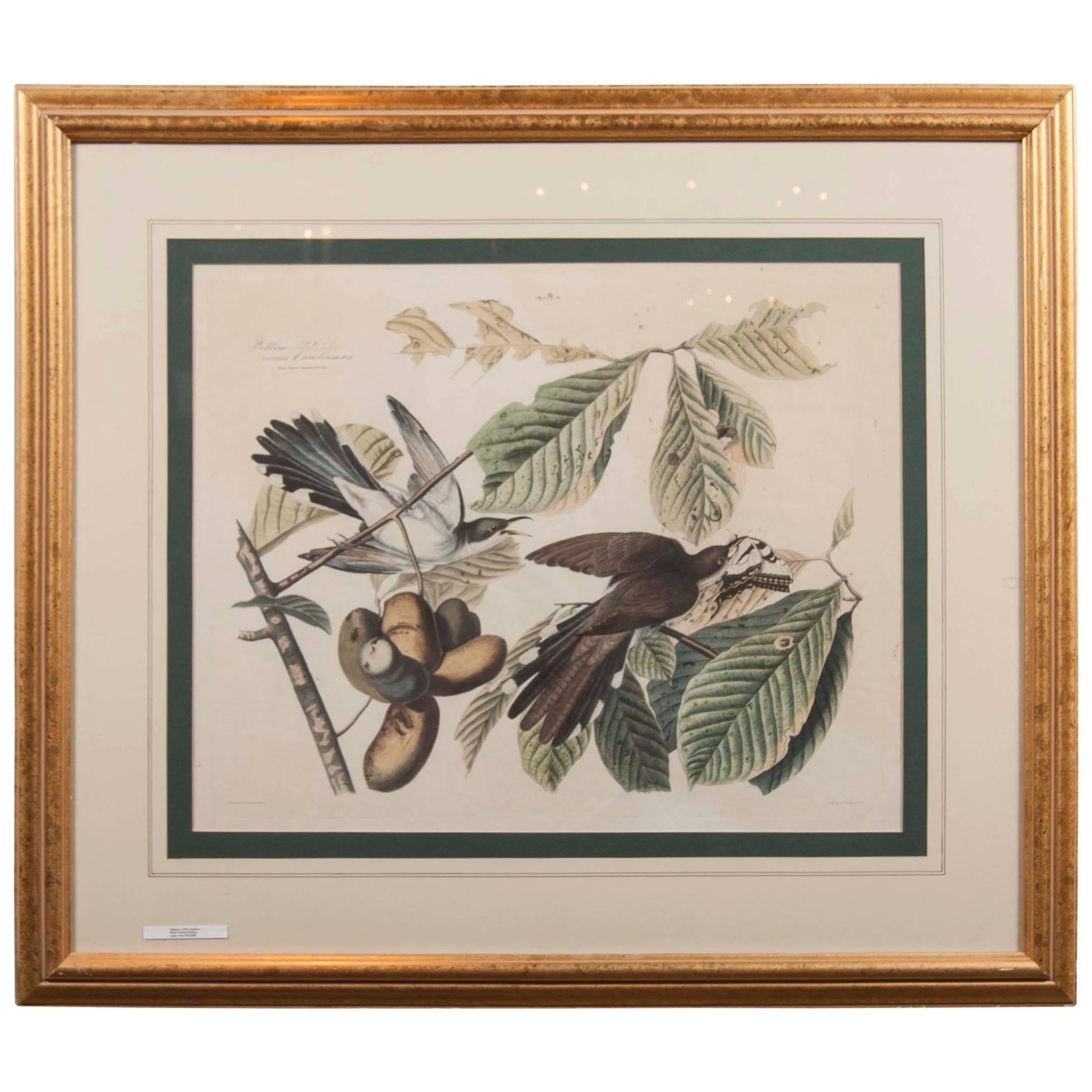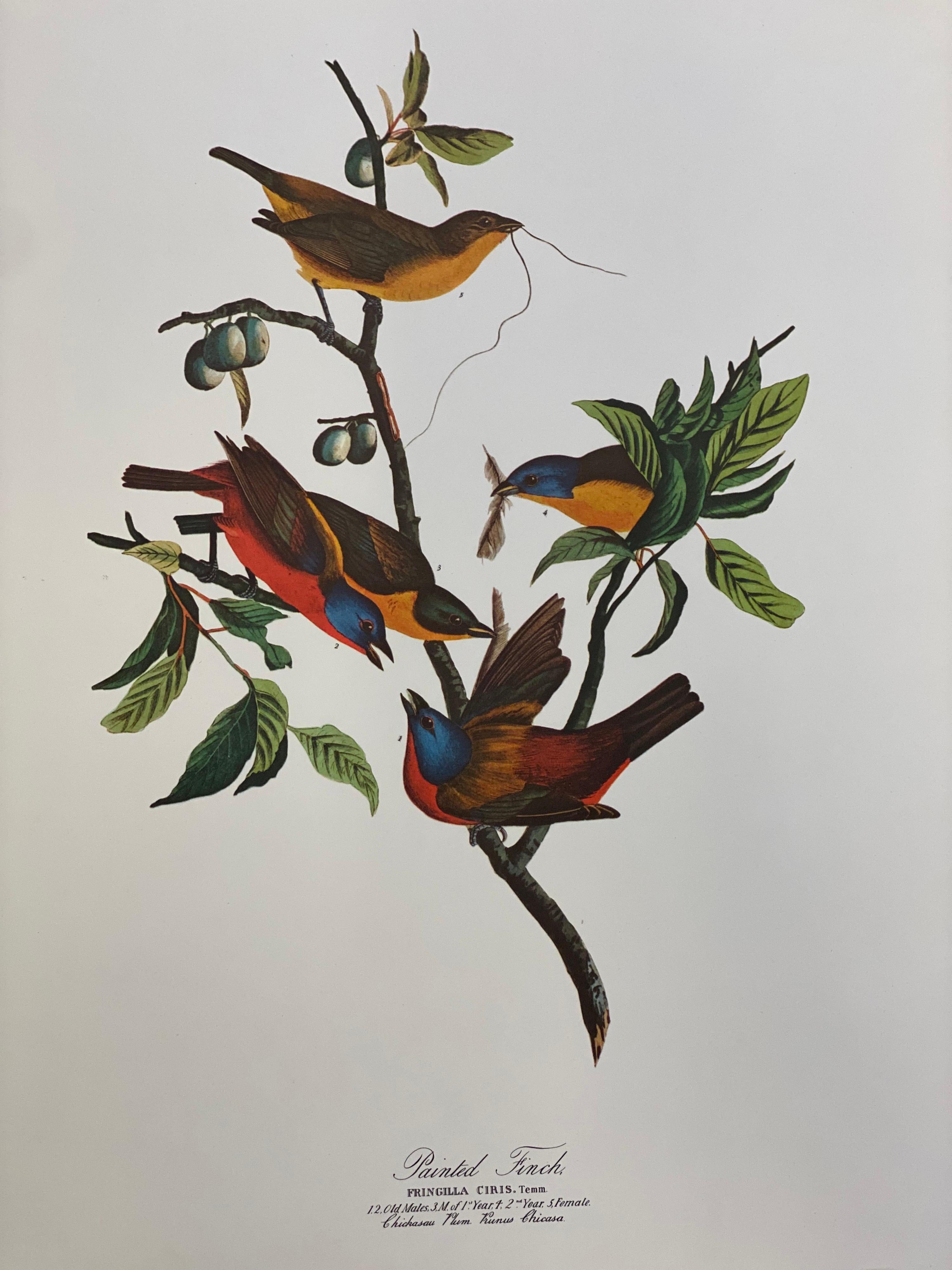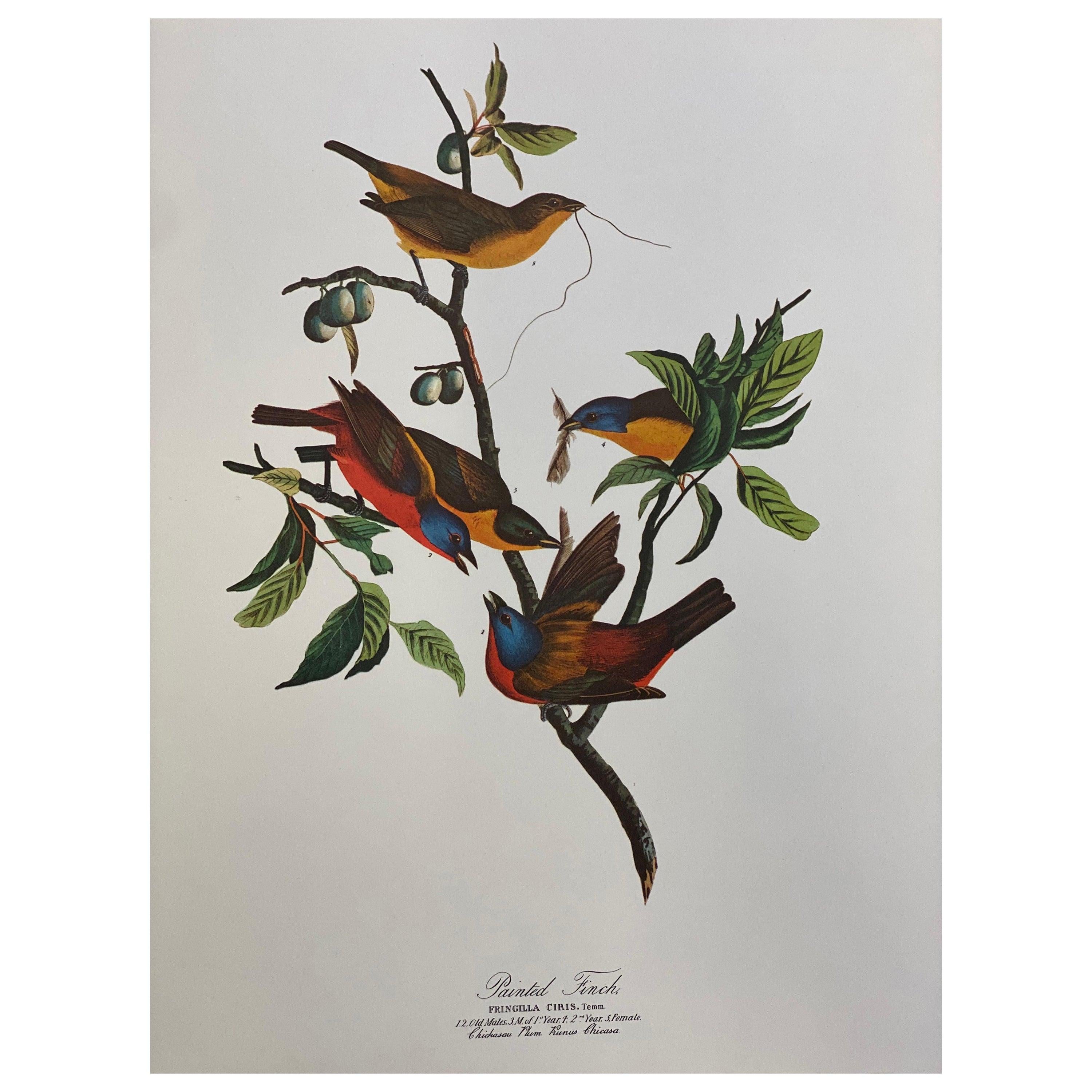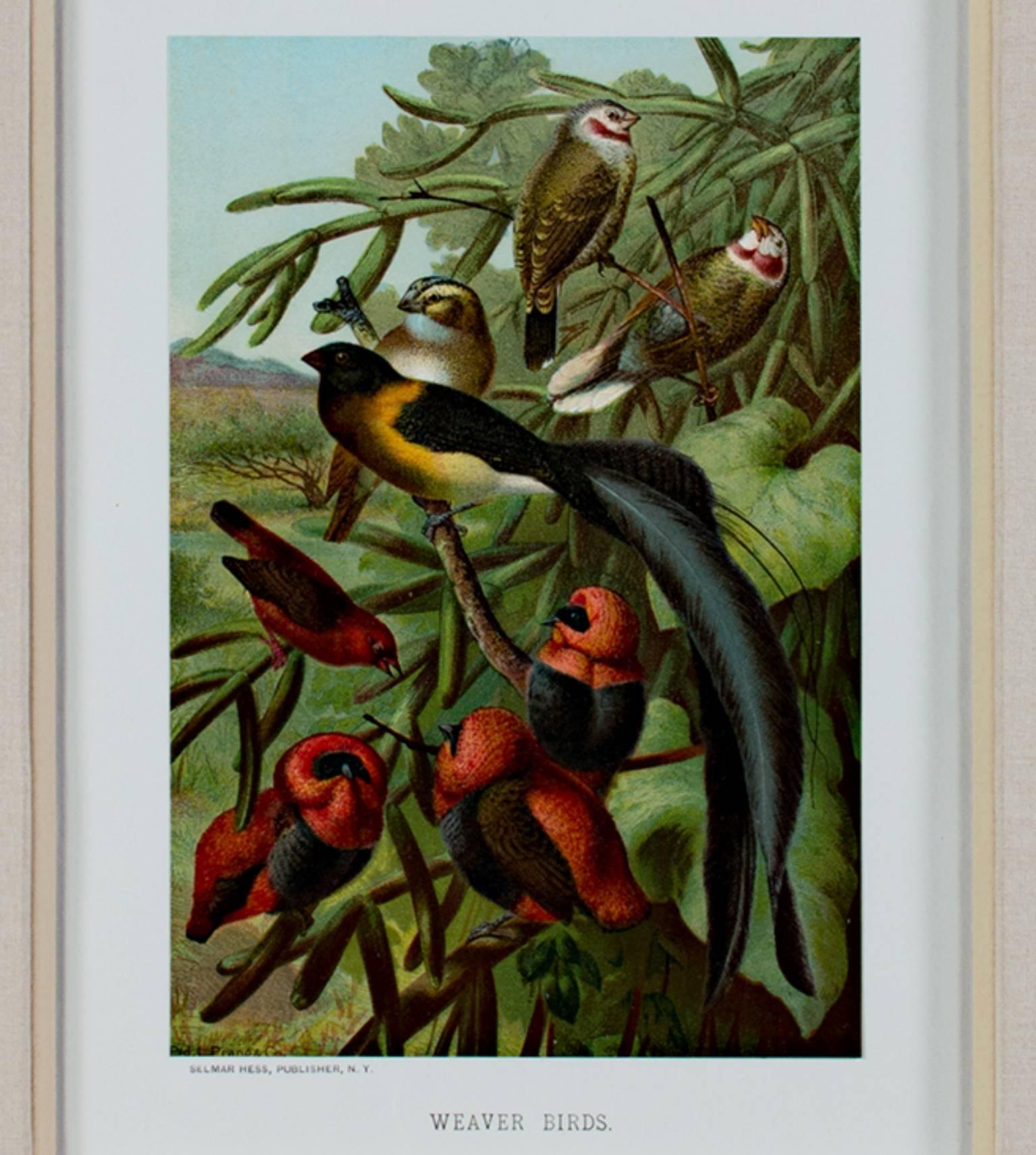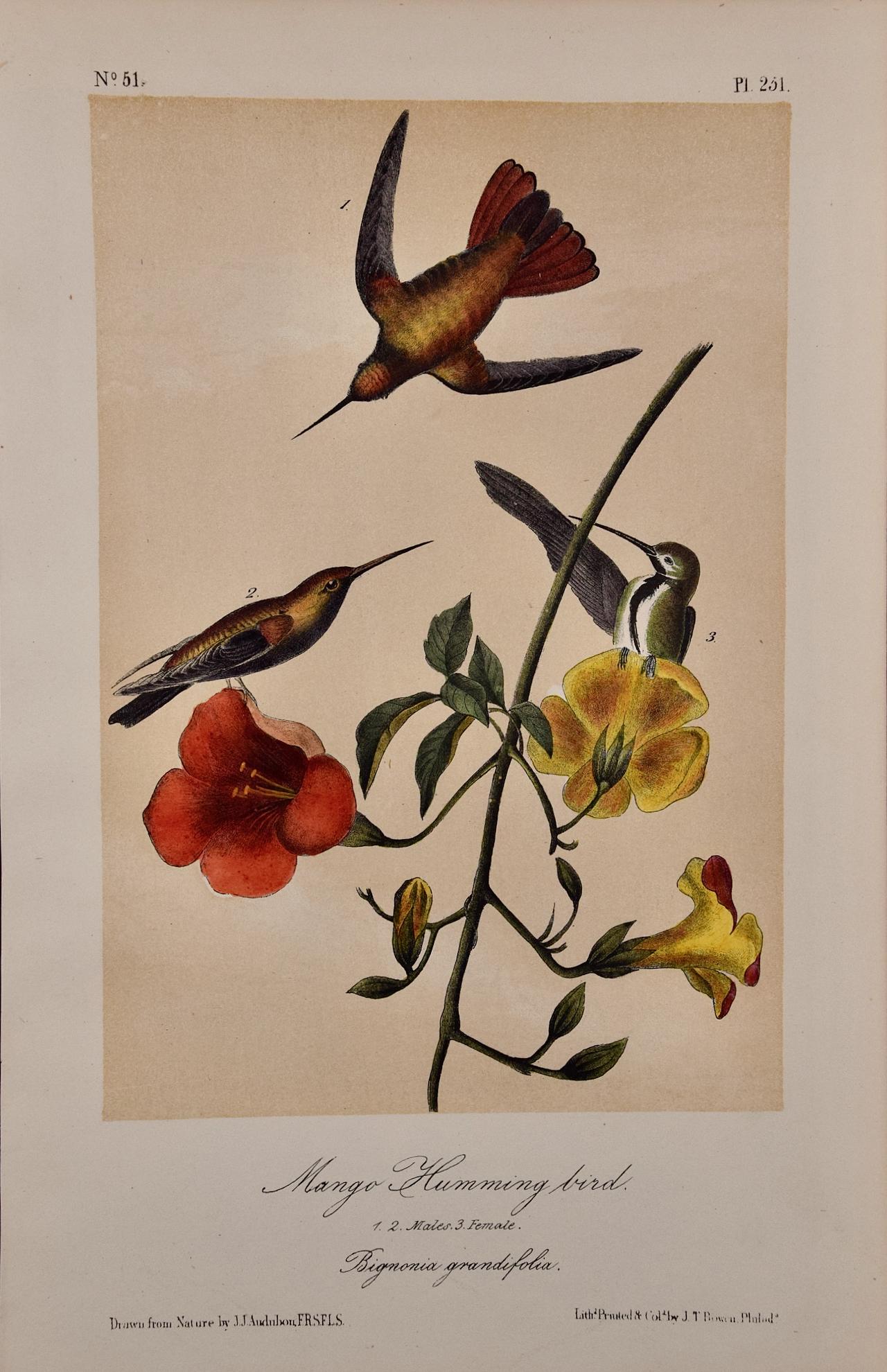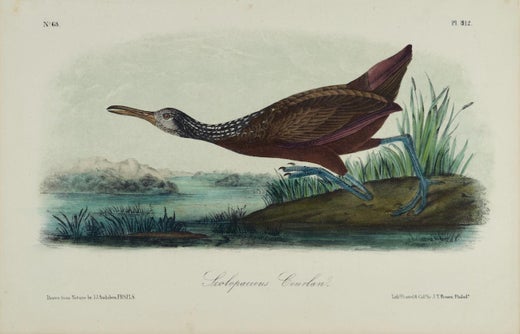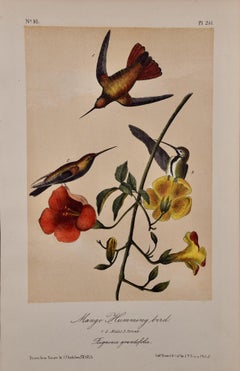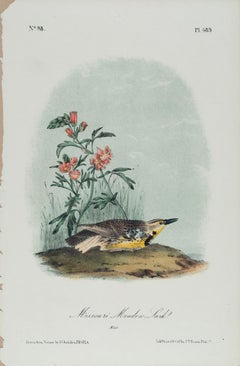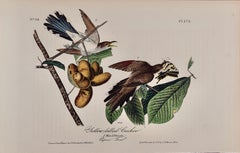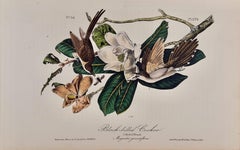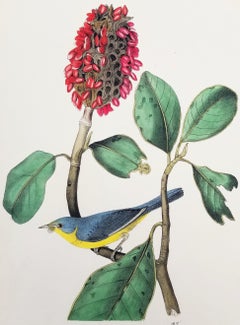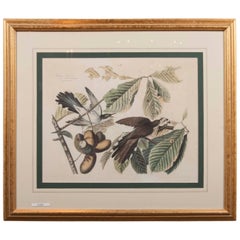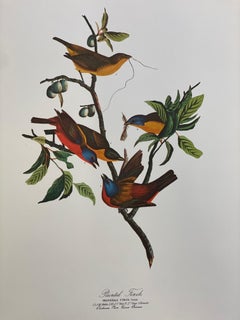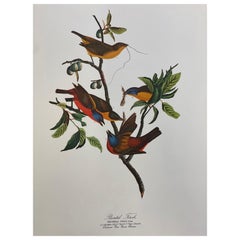Items Similar to Swainson's Warbler: A Framed Original Hand-colored Audubon Folio Bird Engraving
Want more images or videos?
Request additional images or videos from the seller
1 of 11
John James AudubonSwainson's Warbler: A Framed Original Hand-colored Audubon Folio Bird Engraving1828
1828
$3,775
£2,927.02
€3,321.26
CA$5,411.30
A$5,884.02
CHF 3,100.30
MX$71,473.75
NOK 38,977.07
SEK 36,537.86
DKK 24,923.13
About the Item
This is an original John James Audubon hand-colored folio sized lithograph entitled "Swainson's Warbler, Male, Sylvicola Swainsonia, Tree: Vulgo, White Oak", No. 10, Plate 50, from Audubon's "Birds of America". It was engraved, printed and hand colored in London by Robert Havell, Jr. in 1828. It depicts a male Swainson's Warbler bird perched on a branch of a white oak tree, amid large leaves and acorns. Audubon later stated: "This little bird was by mistake engraved, and named after my friend W. Swainson, Esq., during my absence from London, one drawing having been accidentally substituted for another. It is in reality the young of the Black and Yellow Warbler, and was intended to form part of the Plate which will represent the adult male and female of that species.” William Swainson (1789-1855) was the first ornithological illustrator to use lithography, which Audubon later adopted for the production of his octavo edition of the Birds of America.
This original large folio-sized hand colored Audubon bird engraving is presented in an ornate medium brown-colored wood frame with a light tan-colored mat. It is glazed with UV conservation glass and all mounting materials are archival. There are a few short wrinkles, but the print is otherwise in very good condition.
John James Audubon (1785-1851) was a naturalist and artist. He was initially unsuccessful financially prior to the publication of his famous work “The Birds of America”, spending time in debtor’s prison, once stabbing a disgruntled investor in self-defense. However, his obsession with birds and art motivated him to persist in his goal of documenting every bird in America via his watercolor paintings and publishing his works for all to enjoy. Audubon's first illustrations were published in a large elephant folio size. Due to their expense they were purchased in rather small numbers by the wealthy. To reach a larger audience, Audubon, with the help of his sons and J. T. Bowen, published a smaller octavo sized lithograph version, which were much more affordable.
With the success of his bird projects, Audubon then turned his attention to four-legged animals. He explored the Missouri River in 1843 sketching the four-legged animals he encountered in their natural setting. His expedition covered some of the same regions recently explored by Lewis and Clark, traveling from present day Alaska to Mexico. Audubon realized that this was an opportunity to document these animals in the still relatively pristine American wilderness, before man encroached on their environment.
Between 1845 and 1848, Audubon and his sons John Woodhouse Audubon and Victor Gifford Audubon produced a set of elephant folio sized lithographs that were primarily engraved and hand colored by J. T. Bowen in Philadelphia. The publication, which included text descriptions of the animals was published 3 years before Audubon died. As with the birds, this was followed by a three-volume set of 155 octavo-sized plates entitled “The Quadrupeds of North America” completed and published by Audubon’s sons, John, Jr. and Victor.
Audubon prints continue to be popular and a wise investment. The double elephant folio set “The Birds of America” have sold at auction for as much as $8.8 million, and individual plates may sell for six figures. The beautiful octavo sized plates are not as expensive, but becoming more sought after, as the folio bird plates become unattainable to all but the very wealthy.
Robert Havell Jr. (1793-1878) was the main engraver for Audubon's folio Birds of America publication. His aquatint engravings of most of the plates (except for the first ten) is considered a significant artistic achievement and was essential to the success of Audubon's Birds of America. Havell and Audubon became close friends and associates. In 1839 Havell went to America at the invitation of Audubon, first residing in Brooklyn. He settled in Ossining on the Hudson River and later moved to Tarrytown, New York, where he remained for the rest of his life. After the publication of Birds of America, Havell continued to create engravings, but became more known for his landscape and countryside paintings of the Hudson River valley. He travelled frequently in a homemade horse-drawn trailer, sketching and taking notes and translating his sketches into larger oils. He is considered an influential contributor of the Hudson River School of American painters. Havell died in 1878 and is buried in Sleepy Hollow Cemetery in Sleepy Hollow.
- Creator:John James Audubon (1785-1851, American, French)
- Creation Year:1828
- Dimensions:Height: 32.75 in (83.19 cm)Width: 26.25 in (66.68 cm)Depth: 1.13 in (2.88 cm)
- Medium:
- Movement & Style:
- Period:
- Condition:
- Gallery Location:Alamo, CA
- Reference Number:Seller: 36731stDibs: LU117327337372
John James Audubon
John James Audubon (April 26, 1785, Les Cayes, Saint-Domingue (later Haiti) – January 27, 1851 (aged 65) Manhattan, New York, U.S.), born Jean-Jacques Audubon, was an American ornithologist, naturalist, and painter. He was notable for his expansive studies to document all types of American birds and for his detailed illustrations that depicted the birds in their natural habitats. His major work, a color-plate book entitled The Birds of America (1827–1839), is considered one of the finest ornithological works ever completed. Audubon identified 25 new species.
About the Seller
5.0
Platinum Seller
Premium sellers with a 4.7+ rating and 24-hour response times
Established in 2011
1stDibs seller since 2019
293 sales on 1stDibs
Typical response time: 1 hour
- ShippingRetrieving quote...Shipping from: Alamo, CA
- Return Policy
Authenticity Guarantee
In the unlikely event there’s an issue with an item’s authenticity, contact us within 1 year for a full refund. DetailsMoney-Back Guarantee
If your item is not as described, is damaged in transit, or does not arrive, contact us within 7 days for a full refund. Details24-Hour Cancellation
You have a 24-hour grace period in which to reconsider your purchase, with no questions asked.Vetted Professional Sellers
Our world-class sellers must adhere to strict standards for service and quality, maintaining the integrity of our listings.Price-Match Guarantee
If you find that a seller listed the same item for a lower price elsewhere, we’ll match it.Trusted Global Delivery
Our best-in-class carrier network provides specialized shipping options worldwide, including custom delivery.More From This Seller
View AllMango Hummingbirds: An Original 19th C. Audubon Hand-colored Bird Lithograph
By John James Audubon
Located in Alamo, CA
This is an original John James Audubon hand-colored lithograph entitled "Mango Humming bird, 1. 2. Males. 3. Female. Bignonia grandifolia", No. 51, Plate 251 from Audubon's "Birds of America, lithographed, printed and colored by JT Bowen and published in Philadelphia between 1870-1871. The lithograph depicts an adult male hummingbird, labelled 1, in flight above a beautiful flowering plant, a Chinese Trumpet-vine. Another male, labeled 2, is perched on a flower on the left and a female, labelled 3, is perched on a flower on the right.
This hand-colored Audubon bird octavo-size lithograph sheet measures 10.25" high by 6.75" wide. It is in excellent condition. The original text pages, 185-186, from Audubon's 19th century publication are included.
John James Audubon (1785-1851) was a naturalist and artist. He was initially unsuccessful financially prior to the publication of his famous work “The Birds of America”, spending time in debtor’s prison, once stabbing a disgruntled investor in self-defense. However, his obsession with birds and art motivated him to persist in his goal of documenting every bird in America via his watercolor paintings and publishing his works for all to enjoy. Audubon's first illustrations were published in a large elephant folio size. Due to their expense they were purchased in rather small numbers by the wealthy. To reach a larger audience, Audubon, with the help of his sons and J. T. Bowen, published a smaller octavo sized lithograph version, which were much more affordable.
With the success of his bird projects, Audubon then turned his attention to four-legged animals. He explored the Missouri River in 1843 sketching the four-legged animals he encountered in their natural setting. His expedition covered some of the same regions recently explored by Lewis and Clark, traveling from present day Alaska to Mexico. Audubon realized that this was an opportunity to document these animals in the still relatively pristine American wilderness, before man encroached on their environment.
Between 1845 and 1848, Audubon and his sons John Woodhouse Audubon...
Category
Late 19th Century Naturalistic Animal Prints
Materials
Lithograph
Missouri Meadow Lark: An Original 19th C. Audubon Hand-colored Bird Lithograph
By John James Audubon
Located in Alamo, CA
This is an original 19th century John James Audubon hand-colored lithograph entitled "Missouri Meadow Lark, Male", No. 98, Plate 489 from Audubon's "Birds of America, lithographed, p...
Category
Mid-19th Century Naturalistic Animal Prints
Materials
Lithograph
Yellow-billed Cuckoo: An Original 1st Ed. Audubon Hand-colored Bird Lithograph
By John James Audubon
Located in Alamo, CA
This is an original 1st octavo edition John James Audubon hand-colored lithograph entitled "Yellow-billed Cuckoo, 1. Male, 2, Female, Papaw Tree", No. 55, Plate 275 from Audubon's "B...
Category
Mid-19th Century Naturalistic Animal Prints
Materials
Lithograph
Black-billed Cuckoo: An Original 1st Ed. Audubon Hand-colored Bird Lithograph
By John James Audubon
Located in Alamo, CA
This is an original 1st octavo edition John James Audubon hand-colored lithograph entitled "Black-billed Cuckoo, 1. Male, 2, Female, Magnolia Grandiflora", No. 56, Plate 276 from Audubon's "Birds of America, lithographed, printed and colored by J. T. Bowen and published in Philadelphia between 1840-1844. It depicts a female black-billed cuckoo perched on a branch of a magnolia tree reaching for a flying insect. The male appears to be in flight in front of magnolia leaves on the right, perhaps after the same insect. Magnolia flowers are depicted, as well.
This original 1st octavo edition hand-colored Audubon Black-billed Cuckoo lithograph is in excellent condition, other than a few tiny spots in the upper margin and a tiny faint spot in the lower inscription area. The sheet measures 6.5" high by 10.13" wide. The original text pages, 300-302, from Audubon's 19th century publication are included with the lithograph.
John James Audubon (1785-1851) was a naturalist and artist. He was initially unsuccessful financially prior to the publication of his famous work “The Birds of America”, spending time in debtor’s prison, once stabbing a disgruntled investor in self-defense. However, his obsession with birds and art motivated him to persist in his goal of documenting every bird in America via his watercolor paintings and publishing his works for all to enjoy. Audubon's first illustrations were published in a large elephant folio size. Due to their expense they were purchased in rather small numbers by the wealthy. To reach a larger audience, Audubon, with the help of his sons and J. T. Bowen, published a smaller octavo sized lithograph version, which were much more affordable.
With the success of his bird projects, Audubon then turned his attention to four-legged animals. He explored the Missouri River in 1843 sketching the four-legged animals he encountered in their natural setting. His expedition covered some of the same regions recently explored by Lewis and Clark, traveling from present day Alaska to Mexico. Audubon realized that this was an opportunity to document these animals in the still relatively pristine American wilderness, before man encroached on their environment.
Between 1845 and 1848, Audubon and his sons John Woodhouse Audubon and Victor Gifford Audubon produced a set of elephant folio sized lithographs that were primarily engraved and hand colored by J. T. Bowen in Philadelphia. The publication, which included text descriptions of the animals was published 3 years before Audubon died. As with the birds, this was followed by a three-volume set of 155 octavo-sized plates entitled “The Quadrupeds of North America” completed and published by Audubon’s sons, John, Jr. and Victor.
Audubon prints continue to be popular and a wise investment. The double elephant folio set...
Category
Mid-19th Century Naturalistic Animal Prints
Materials
Lithograph
Golden-winged Woodpecker: First Octavo Edition Audubon Hand-colored Lithograph
By John James Audubon
Located in Alamo, CA
This is an original John James Audubon hand-colored royal first octavo edition lithograph entitled "Golden-winged Woodpecker, 1. Male, 2. Female2", No. 55...
Category
Mid-19th Century Naturalistic Animal Prints
Materials
Lithograph
18th Century Catesby Hand-colored Bird & Plant Engraving "The Crested Titmous"
By Mark Catesby
Located in Alamo, CA
A hand-colored copperplate engraving of a bird and plants by Mark Catesby (1683-1749) entitled "The Crested Titmous" from "The Natural History of Carolina, Georgia, Florida and the Bahama Islands", published in 1731. It depicts a small Crested Titmous bird, facing left, perched on the stem of a plant with clusters of mauve colored star-like flowers.
This original Catesby hand-colored engraving, on laid paper with a large central Fleur-de-Lys watermark, is presented in a cream color French mat. The mat measures 20" x 15.5" and the sheet measures 18.75" x 14.75".
Mark Catesby was born in England to a prosperous family, but he traveled to America, first to visit his sister and her husband in 1712. From 1712 to 1719 he explored America observing its birds and plants, taking notes, creating drawings and collecting specimens. He returned to England with this material and created more detailed drawings. His next visit to America 1722-1726 allowed for more detailed research. Upon his return to England he created his monumental and beautiful work "The Natural History of Carolina, Florida, and Bahama Islands", which was published in London in two folio volumes of 11 parts each consisting of 20 plates...
Category
Mid-18th Century Naturalistic Animal Prints
Materials
Engraving
You May Also Like
Bonaparte’s Flycatching-Warbler (Great Magnolia) /// Ornithology Bird Audubon
By John James Audubon
Located in Saint Augustine, FL
Artist: John James Audubon (American, 1785-1851)
Title: "Bonaparte’s Flycatching-Warbler (Great Magnolia)" (Plate 73, No. 15)
Portfolio: The Birds of America, First Royal Octavo Edition
Year: 1840-1844
Medium: Original Hand-Colored Lithograph on wove paper
Limited edition: approx. 1,200
Printer: John T. Bowen, Philadelphia, PA
Publisher: John James Audubon and J.B. Chevalier, New York, NY and Philadelphia, PA
Sheet size: 10.5" x 6.5"
Image size: 7.5" x 5.63"
Condition: Minor area of discoloration upper right corner. In excellent condition with strong colors
Notes:
Lithography and hand-coloring by American artist John T. Bowen (1801-c.1856). Comes from Audubon's famous seven volume portfolio "The Birds of America", First Royal Octavo Edition (1840-1844), which consists of 500 hand-colored lithographs.
Based on a composition painted on August 13, 1821.
The Canada warbler is a small boreal songbird of the New World warbler family. It summers in Canada and northeastern United States and winters in northern South America.
To make 'The Birds of America' more affordable and widely available, in 1839 John James Audubon began the first octavo edition, a smaller version of the folio which was printed and hand-colored by J. T. Bowen in Philadelphia. Employing a new invention, the camera lucida, the images were reduced in size, rendered in intermediate drawings by John James Audubon and his son John Woodhouse, and then drawn onto lithographic stones. These miniatures exhibit a remarkable amount of attention to quality and detail, as well as a meticulous fidelity to the larger works. Some compositional changes were made in order to accommodate the smaller format. Like the Havell edition, John James Audubon’s first...
Category
1840s Victorian Animal Prints
Materials
Watercolor, Lithograph
Audubon Print of the Yellow-Billed Cuckoo
By John James Audubon
Located in Stamford, CT
A rare original large folio size hand-colored etching, plate # 2 in Audubon's "Birds of North America." This is a rare printing of a first edition by Lizars. Only 50 copies of the fi...
Category
Antique 1820s American American Classical Prints
Materials
Paper
Large Classical Bird Color Print after John James Audubon - Painted Finch
By After John James Audubon
Located in Cirencester, Gloucestershire
Classical Bird print,
after John James Audubon,
printed by Harry N. Abrams, Publishers, New York
unframed, 17 x 14 inches color print on pap...
Category
20th Century Victorian Animal Prints
Materials
Color
Large Classical Bird Color Print after John James Audubon, Painted Finch
Located in Cirencester, Gloucestershire
Classical Bird print,
after John James Audubon,
printed by Harry N. Abrams, Publishers, New York
unframed, 17 x 14 inches color print on paper
condition: very good
provenance: from...
Category
20th Century Victorian More Prints
Materials
Acrylic
19th century color lithograph birds nature tree leaves nature scene signed
By Louis Prang
Located in Milwaukee, WI
"Weaver Birds" is an original color lithograph by Louis Prang. It depicts multiple weaver birds with leaves surrounding them.
8 1/4" x 5" image
12 1/2" x...
Category
Late 19th Century American Realist Animal Prints
Materials
Lithograph
Stunning Handcolored Old Bird Print of the Willow Wren & Icterine Warbler, 1832
Located in Langweer, NL
Antique bird print titled 'Sylvia Hippolais - Sylvia Icterina'. Old bird print showing the willow wren and icterine warbler. This print originates from 'Iconografia della fauna itali...
Category
Antique 1830s Prints
Materials
Paper
$414 Sale Price
20% Off
More Ways To Browse
Antique Engraving Plates
Bird On A Perch
Bird Engraving
Antique Bird Engravings
Ornate Wood Frames
19th Hand Colored Engraving
19th Century Colored Engraving
19th Century Engraving Framed
Hudson Valley Antique
Framed Audubon
19th Century Bird Engraving
Damien Hirst The Souls
David Hockney Boodge
Francisco Toledo Etching
George Rodrigue Texas
George Rodrigue Tie
George Rodrigue Top Dog
George Studdy
